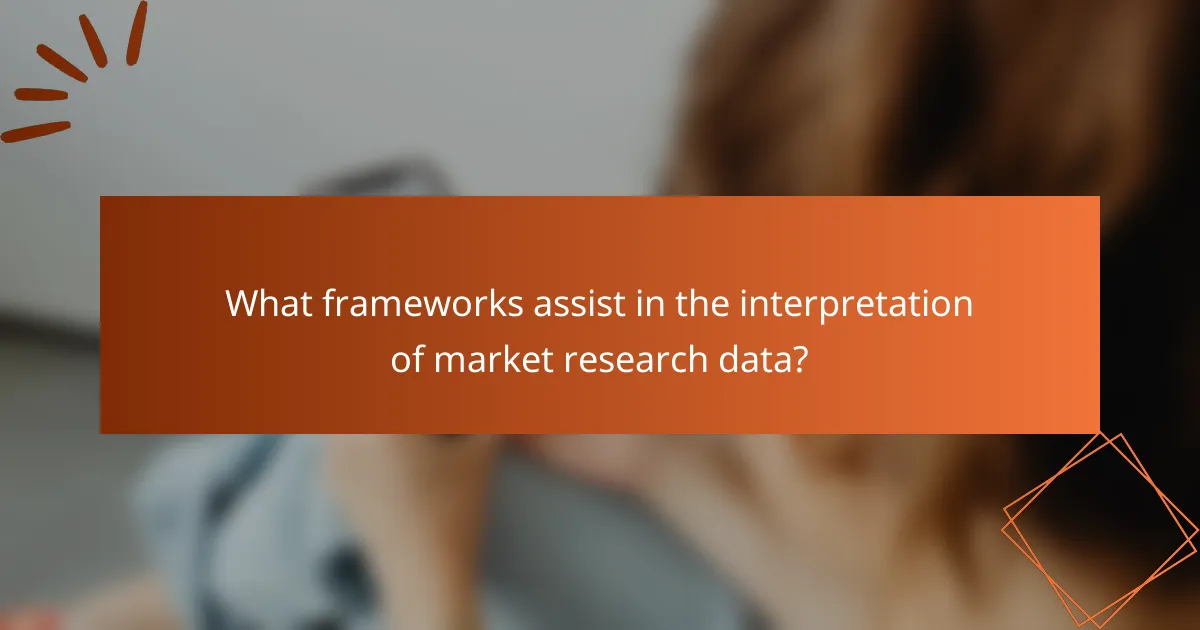Interpreting market research data is crucial for businesses seeking to understand consumer behavior and market trends. Utilizing effective techniques such as qualitative and quantitative analysis, data visualization, and sentiment analysis can yield valuable insights. However, analysts must navigate challenges like data quality and bias to ensure the reliability of their findings, ultimately enabling companies to make informed decisions that drive competitiveness and profitability.

What techniques are effective for interpreting market research data?
Effective techniques for interpreting market research data include qualitative and quantitative analysis methods, data visualization tools, statistical software applications, and sentiment analysis techniques. Each approach offers unique insights and can be selected based on the specific research objectives and data types involved.
Qualitative analysis methods
Qualitative analysis methods focus on understanding the underlying reasons and motivations behind consumer behavior. Techniques such as focus groups, in-depth interviews, and open-ended surveys allow researchers to gather rich, descriptive data. These methods are particularly useful for exploring new concepts or gaining insights into customer experiences.
When using qualitative analysis, ensure that the sample size is adequate to capture diverse perspectives, typically ranging from 5 to 30 participants depending on the study’s scope. Be mindful of biases that may arise from group dynamics in focus groups.
Quantitative analysis methods
Quantitative analysis methods involve the use of numerical data to identify patterns and trends. Surveys with closed-ended questions, experiments, and observational studies are common techniques. This approach allows for statistical analysis, making it easier to generalize findings to a larger population.
When designing quantitative studies, aim for a sample size that provides sufficient power, often in the hundreds or thousands, depending on the desired confidence level. Use random sampling to minimize bias and enhance the reliability of results.
Data visualization tools
Data visualization tools help present complex data in a clear and accessible format. Tools like Tableau, Microsoft Power BI, and Google Data Studio enable researchers to create charts, graphs, and dashboards that highlight key findings. Effective visualizations can reveal trends and relationships that might not be immediately apparent in raw data.
When using data visualization, prioritize clarity and simplicity. Avoid cluttered visuals; instead, focus on key metrics and insights that support your research objectives. Use color and design strategically to enhance understanding.
Statistical software applications
Statistical software applications such as SPSS, R, and SAS are essential for conducting advanced data analysis. These tools allow researchers to perform complex statistical tests, manage large datasets, and generate detailed reports. They are particularly useful for quantitative research where rigorous analysis is required.
Familiarize yourself with the capabilities of each software to choose the best fit for your needs. Consider factors like user interface, available features, and community support when selecting a statistical tool.
Sentiment analysis techniques
Sentiment analysis techniques assess consumer opinions and emotions expressed in text data, such as social media posts or customer reviews. By using natural language processing (NLP) tools, researchers can categorize sentiments as positive, negative, or neutral, providing insights into public perception.
When implementing sentiment analysis, ensure that the data source is relevant and representative of your target audience. Be aware of the limitations of automated sentiment analysis, such as misinterpretation of sarcasm or context, and consider supplementing it with qualitative insights for a more comprehensive understanding.

What challenges do analysts face in market research data interpretation?
Analysts encounter several challenges when interpreting market research data, including issues related to data quality, bias in data collection, complexity in integrating diverse data sources, and the ambiguity of results. These challenges can significantly impact the accuracy and reliability of insights drawn from the data.
Data quality issues
Data quality issues arise when the information collected is inaccurate, incomplete, or outdated. Analysts must ensure that the data is reliable and representative of the target market to draw valid conclusions. Regular audits and validation checks can help identify and rectify data quality problems.
Common data quality problems include missing values, duplicate entries, and inconsistencies across datasets. Implementing robust data management practices, such as standardization and cleansing processes, can mitigate these issues and enhance overall data integrity.
Bias in data collection
Bias in data collection can skew results and lead to misleading interpretations. This bias may stem from the selection of respondents, survey design, or even the timing of data collection. Analysts should be aware of potential biases and strive to minimize them through careful planning and execution.
To reduce bias, consider employing random sampling techniques and ensuring diverse representation in the sample population. Additionally, using neutral language in surveys can help avoid leading respondents toward specific answers.
Complexity of data integration
Integrating data from multiple sources can be complex due to differences in formats, structures, and definitions. Analysts must navigate these complexities to create a cohesive dataset that accurately reflects the market landscape. Effective data integration requires a clear understanding of each data source and its relevance to the research objectives.
Utilizing data integration tools and platforms can streamline the process, allowing for easier merging and analysis of disparate datasets. Establishing a common framework for data definitions and metrics can also facilitate smoother integration.
Interpreting ambiguous results
Ambiguous results can arise when data does not clearly indicate a trend or insight, making interpretation challenging. Analysts must be cautious in drawing conclusions from such data and consider multiple perspectives before making recommendations. Contextual factors, such as market conditions and consumer behavior, should also be taken into account.
To address ambiguity, analysts can employ statistical techniques to assess the significance of findings and explore alternative explanations. Engaging stakeholders in discussions about the implications of ambiguous results can also provide valuable insights and foster collaborative decision-making.

How can businesses leverage market research insights?
Businesses can leverage market research insights to make informed decisions that enhance their competitiveness and profitability. By analyzing data on consumer behavior, preferences, and market trends, companies can tailor their strategies to meet customer demands effectively.
Improving product development
Market research insights are crucial for guiding product development. By understanding customer preferences and pain points, businesses can create products that better meet market needs. For instance, conducting surveys or focus groups can reveal desired features or improvements, allowing companies to prioritize development efforts.
Additionally, businesses can use prototype testing to gather feedback before full-scale production. This iterative approach minimizes the risk of launching products that do not resonate with consumers.
Enhancing marketing strategies
Effective marketing strategies are built on a foundation of solid market research. Insights into target demographics, buying behaviors, and media consumption can help businesses craft messages that resonate with their audience. For example, understanding that a significant portion of a target market prefers social media can lead to more effective digital marketing campaigns.
Moreover, analyzing past marketing campaigns can provide valuable lessons on what works and what doesn’t, enabling businesses to refine their approaches continuously.
Identifying customer needs
Identifying customer needs is a key benefit of market research. Through techniques like surveys, interviews, and observational studies, businesses can gain a deeper understanding of what customers truly want. This insight allows for the development of tailored solutions that directly address consumer demands.
Regularly engaging with customers through feedback mechanisms can help businesses stay attuned to changing preferences, ensuring they remain relevant in a dynamic market.
Optimizing pricing strategies
Market research can significantly enhance pricing strategies by providing insights into consumer price sensitivity and competitor pricing. By analyzing how much customers are willing to pay, businesses can set prices that maximize revenue while remaining attractive to buyers. For example, conducting a price elasticity study can reveal how changes in price might affect demand.
Additionally, comparing prices with competitors can help businesses position themselves effectively in the market. It’s essential to consider both perceived value and market trends when determining optimal pricing strategies.

What frameworks assist in the interpretation of market research data?
Several frameworks can enhance the interpretation of market research data by providing structured approaches to analysis. Key frameworks include SWOT and PESTLE analysis, which help identify strengths, weaknesses, opportunities, threats, and external factors influencing a market.
SWOT analysis framework
The SWOT analysis framework evaluates a business or product by identifying its strengths, weaknesses, opportunities, and threats. This method allows teams to assess internal capabilities and external market conditions, facilitating strategic planning.
To conduct a SWOT analysis, gather a cross-functional team to brainstorm each quadrant. For example, a tech startup might identify its innovative product design as a strength, while limited funding could be a weakness. Opportunities might include emerging markets, and threats could involve competitive pressures.
When using SWOT, ensure that the analysis is realistic and based on data. Avoid overly optimistic assessments and focus on actionable insights that can guide decision-making.
PESTLE analysis framework
The PESTLE analysis framework examines external factors affecting a business, categorized into Political, Economic, Social, Technological, Legal, and Environmental influences. This comprehensive view helps organizations understand the broader context in which they operate.
To perform a PESTLE analysis, collect relevant data on each category. For instance, a company operating in the European Union may need to consider regulations affecting data privacy (Legal) and shifts in consumer behavior towards sustainability (Environmental). This analysis can reveal trends that may impact strategic direction.
Be cautious of overemphasizing any single factor; a balanced view is crucial. Regularly update your PESTLE analysis to reflect changing conditions, ensuring that your strategies remain relevant and informed.

How do geographic factors influence market research data interpretation?
Geographic factors significantly affect how market research data is interpreted, as they shape consumer preferences, behaviors, and purchasing power. Understanding these influences is crucial for tailoring marketing strategies to specific regions.
Regional consumer behavior differences
Consumer behavior can vary widely across different regions due to cultural, economic, and social factors. For instance, urban consumers may prioritize convenience and brand reputation, while rural consumers might focus on price and product availability. Recognizing these differences helps businesses adapt their offerings to meet local needs.
Additionally, factors such as income levels and education can influence purchasing decisions. In wealthier regions, consumers may be more inclined to spend on premium products, whereas in less affluent areas, value for money becomes a priority.
Market trends in urban vs rural areas
Urban areas often experience faster market trends due to higher population density and greater access to information. Trends such as online shopping and sustainable products may gain traction more quickly in cities compared to rural areas, where traditional shopping methods may still dominate.
Conversely, rural markets might show a slower adoption of new trends but can present unique opportunities. For example, local products and services that cater to community needs often thrive in these areas. Businesses should analyze urban-rural dynamics to identify potential gaps and opportunities in their market strategies.

